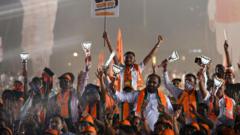Maharashtra's election results indicate a significant lead for Prime Minister Narendra Modi's Bharatiya Janata Party (BJP), reinforcing the party's dominant position in India’s richest state. Current projections suggest the BJP, along with its allies, may secure around 220 of the 288 available seats, surpassing the critical halfway threshold to form the next state government comfortably. This election marks the first regional vote since Modi began his historic third term earlier this year, resulting in a critical return for BJP after losing ground in parliamentary contests.
With Mumbai as its financial heart, Maharashtra holds unparalleled political importance, setting the stage for the BJP to potentially reclaim its foothold. Notably, the BJP's upward trajectory starkly contrasts with the situation in the eastern state of Jharkhand, where the main opposition, Congress, and allies appear to be winning decisively. The volatility in Jharkhand, highlighted by the tumultuous reelection efforts after Chief Minister Hemant Soren faced corruption charges, reflects the broader turmoil in Indian local politics.
While the BJP celebrates its electoral traction in Maharashtra, the trends indicate a precarious balancing act is ahead, particularly as the party leverages its campaign on promises of welfare aimed at the agrarian community in this agricultural powerhouse. BJP spokesperson Pravin Darekar enthusiastically remarked on the unexpected strength of their lead, signaling the party's renewed vigor.
However, such extensive commitments from all sides raise concerns about the resulting fiscal pressures on the state government. With promises stretching from farm loan waivers to incentives for vulnerable populations, the ability to meet these pledges could become a contentious issue among voters.
Beyond the ballots, the implications of these elections extend into the communities themselves, particularly for marginalized groups like tribal populations in Jharkhand, which comprise about 9% of India's demographics. These communities have often remained on the fringes of political discourse, raising questions about the effectiveness and sincerity of the welfare initiatives promised by any incoming government.
Both Maharashtra and Jharkhand encapsulate the intricate dynamics of local governance in India, where promises made during election seasons are tested against the realities of political partnerships and economic dictates. As results unfold, the challenges and complexities facing the BJP and its rivals will significantly shape the future of the regions they govern.






















